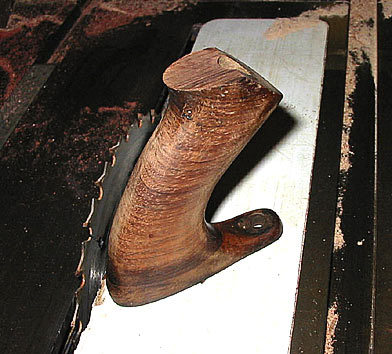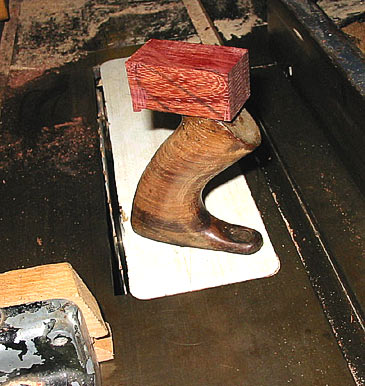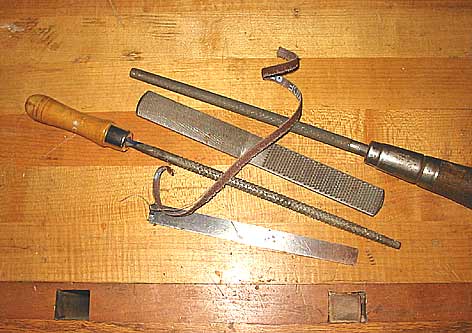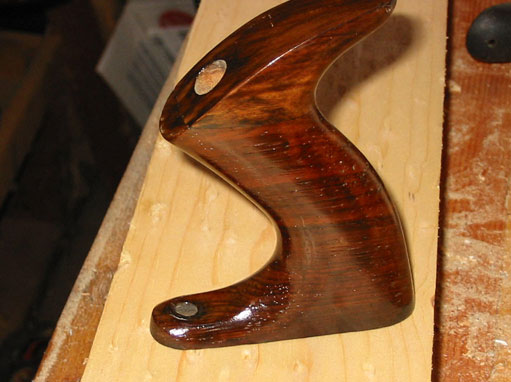 Fix That Tote
Fix That Tote
August and Most Serious Galoots
The following is a most sincere invitation to a better life for you.
So, tell me, Galoots young and old....
How many times have you passed on a good plane just because the tote was
chipped?
Tired of all those chipped totes you already have in your life are you?
Suffering from sleepless nights while your skin is flaking like snow and
your nerves are shot to smithereens from one more great tool you had to walk
past because the tote was chipped?
You think you can't fix it? Think it's too hard and you'll never get a
good job and it'll stick out like a sore thumb from 55 yards away? Well
fret no more!
Have we got the cure for you! A secret good men have died to protect.
The very miracle of the age. Passed down hand to mouth by the secret fakirs
of ancient legend, simple and perfect everytime.
And.......... If you act now we'll throw in, completely free and
without further obligation, for only the price of postage or a good mellow
drink, whichever is cheaper.................
Now, who will be the first? Step right up, don't be shy
|
 |
| |
|
|
Only
one in 3planes out there in the wild escape the chipped tote horn. At the
swap meet or yard sale or ebay it makes most of the difference between a $5
plane and a $50 plane.
You know the story.
You see a great plane and there you are wondering if you should take it or let
it go. Most will just leave it be because finding a good original tote can cost
about as much as another whole plane with a perfect tote and it takes time to
find even a single one. Replacement newly made totes are available but again
these cost about as much as the plane you were thinking of putting them on many
times. And about 75% of the time it's the tote tip that is chipped or missing in
action. We've all seen it and passed them by about a million times mostly just
for this defect alone.
But fixing them is easy! Easy I say.
The trick is cutting off the offending area
parallel with the bottom. If the cleanup cut is made any old place you can't get
a clamp on it. Without a clamp your repair is going to stick out like a sore
thumb from 50 yards and probably fall back off in a year or two. When it's
parallel any vise or sturdy clamp will give you plenty of pressure to make a
tight permanent glue joint. It's why clamps were invented.
There are other ways of squaring up your
gluing surface, I know, but the easiest and fastest for me is shown here.
|
| |
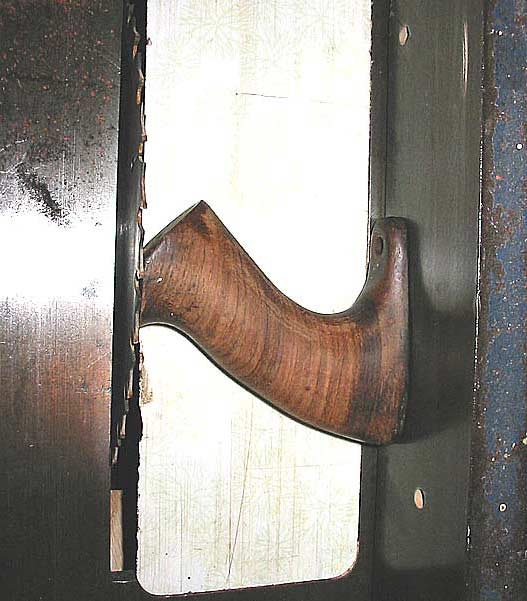
This is an ordinary table saw rip fence with
the tote being cut.
A
good sharp fine tooth blade and a slow easy feed does it here.
This results in a smooth flat surface parallel to the base.
Next, pick through your scraps for a nice grain match in rosewood. If you have a
different species of rosewood that's ok, you can stain to match easy later, just
try to line up the grain lines.
This is a
scrap of purpleheart I just grabbed and placed on top.
|
You'll want to be sure to select your repair
piece oversized. Longer, wider and thicker if you can. Make the horn longer and
especially watch the curve up the back. It'll look larger than it really is at
first. Once you start to round this off it begins to look differently, so leave
extra. I realize this picture makes it look like I marked out for minimal but
trust me it's considerable bigger than it looks. See what I mean about not
trusting your eyes?
Of course you will be grain matching
rosewood instead of purpleheart. I just wanted it so show up for the picture.
I've read many accounts of gluing rosewood.
I've tried lots of different types of glue
too. One school says you need to remove the natural oil present and I've used
acetone for that. I've even taken the point of a scratch awl and scratched up
the gluing surfaces taking care not to go beyond the finish lines. I did this
for years and used epoxy or polyurethane glue. Gradually I started to use less
and less of this extreme precaution though. These days I simply use ordinary
yellow carpenters wood glue available anywhere. After 24 hours in the vise I
cannot break the bond with my hands alone, even pressing between my knees, so I
figure that's good enough for the girls I know. I've never had one fail on me.
It's the smooth gluing surface and even clamping pressure that seems to do it.
Once it's cured well
Take it out of the vise and give it a good
tug. Really try to break it. You'll see, you can't.
OK, weightlifters and guys who can pull 26
loaded semi trucks down the road with a rope in their teeth might be excused
from this part. But a good strong average pull is my point. It'll hold.
Carve it to shape.
I will use round rasps and files. I
especially like the small 6" shoe rasp with fine rasp teeth and coarse file
teeth, both flat and 1/2 round. When these are sharp they are just a joy.
Next comes a scraper. I like them thin,
narrow and flexible for curved work like this. There is another article on
making the flexy scrapers on this site.
Finishing
After scraping it's possible you'll need to
sand it some. I'll use strips of belt sander belt, ripped into narrow strips and
applied shoeshine style. My final sanding never goes past 220.
After sanding I polish rosewood and anything
harder than that. A med sewed cotton buffing wheel, turning around 1000 rpm and
med aluminum oxide polish will make it sparkle in minutes. Once you've buffed
rosewood you'll never go back to any other kind of finish. It looks great, feels
like warm buttah against your skin and if you need to renew it for some reason
it only takes 5 minutes more.
Staining
In case your rosewood patch didn't quite
match for color, I've found an interesting thing. Minwax Jocabean stain, a
deep muddy brownish black color, usually always brings the tone right close to
Indian rosewood. Even on the lighter rosewoods like Bolivian the color match is
spot on. It's the grain pattern you need to watch when aligning the patch. After
that the color is easy.
Both these totes were repaired using this
method.
yours Scott

 Fix That Tote
Fix That Tote
